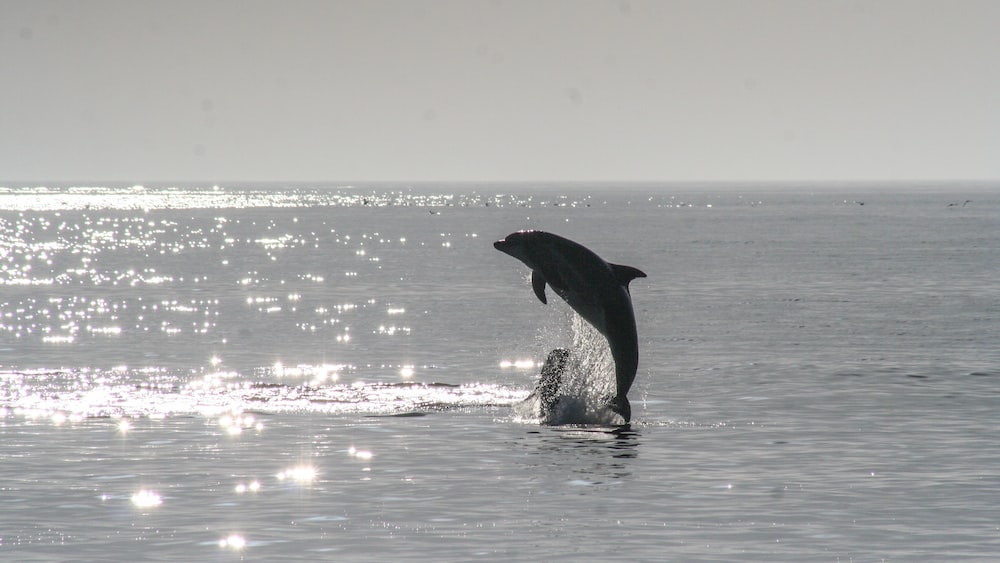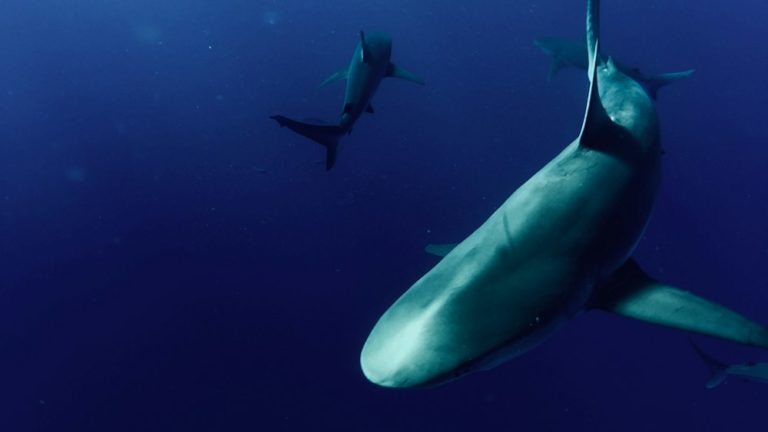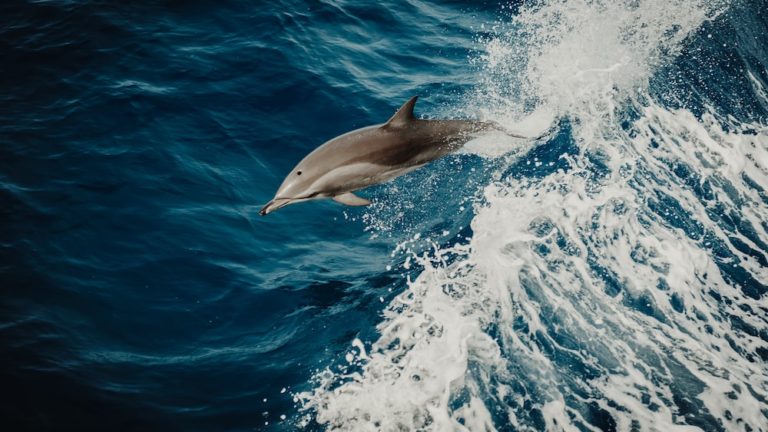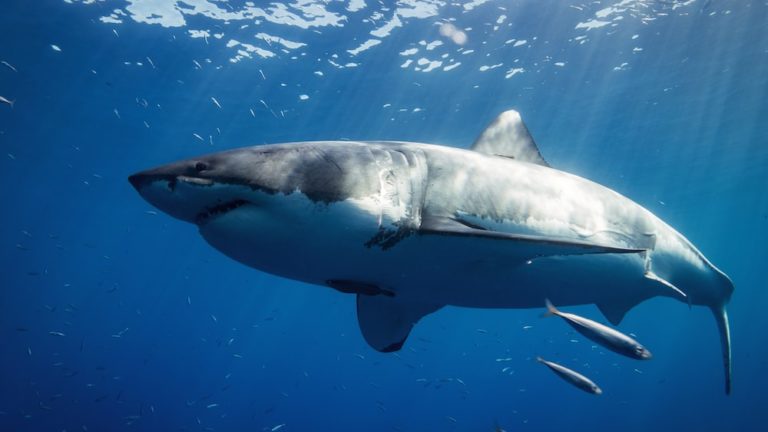The Difference Between A Shark And A Dolphin
The Difference Between A Shark And A Dolphin
Imagine you’re gliding through the crystal-clear waters, the sun’s rays filtering down in a serene dance of light. Amidst this underwater ballet, two charismatic performers take the stage: the shark and the dolphin. They may share the same stage, but the difference between a shark and a dolphin is vast, from the calm glide of the dolphin to the stealthy prowl of the shark.
To the untrained eye, it’s easy to confuse a fin slicing through the waves as a sign of danger; “Shark!” But more often than not, it’s just a friendly dolphin coming to say hello. There’s a world of difference that sets them apart, and it’s high time we dive deep into their realms to clear up any confusion. Let’s swim through the facts and fiction to uncover what truly makes these two incredible creatures distinct.
Surprisingly, amidst the sea of differences, there are times when sharks and dolphins are mistaken for the other, like a shark costume at a marine parade – similar at a glance but fundamentally unique upon closer inspection. And so, with the spirit of an ocean-bound detective, we’ll carefully piece together the clues that reveal the essence of these marine marvels.
Defining Sharks and Dolphins
As we set sail on this journey of discovery, it’s paramount to understand what constitutes a shark and a dolphin beyond what is often shark written in popular culture. Our exploration will take us through the vast blue, from the shark‘s sleek, streamlined form to the dolphin‘s intelligent, playful presence. Here, we will unfold the layers of mystique that surround these two oceanic icons.
What Are Sharks?
Sharks, those streamlined hunters of the deep, date back over 400 million years, even before the age of dinosaurs. These cartilaginous fish, members of the elasmobranch family, lack the true bones that dolphins and other mammals boast. Instead, their skeletons are comprised of lightweight, flexible cartilage, a trait that enables them to be the fluid and efficient predators that they are.
As one delves into their world, you’ll find over 500 species of sharks, from the small and harmless dwarf lanternshark to the formidable and widely recognized great white shark. Each species has evolved the skills needed to thrive in a range of marine environments, from shallow coral reefs to the dark abyss of the deep sea. Behold, as we now peel back the ocean’s veil on these oft-misunderstood creatures.
Sharks have evolved over 400 million years to become efficient and diverse predators in various marine environments.
What Are Dolphins?
Dolphins are the twinkling stars in the great aquatic tapestry, renowned for their intelligence and gregarious nature. Unlike their cartilaginous counterparts, dolphins are warm-blooded mammals that traverse the globe’s oceans. Birthed live and nursed with milk, they embody characteristics that resonate deeply with us land-dwellers.
These marine mammals belong to the Cetacean order, more specifically the Delphinidae family. About 40 species of dolphins cut the waves, with the bottlenose dolphin often stealing the spotlight in marine parks or alongside boats gliding through the ocean. No discussion about the ocean’s synergy is complete without acknowledging the dolphin’s joyous leaps and their sonic brilliance – their echolocation is nothing short of nature’s acoustic marvel.
Physical Characteristics
As we navigate through the kelp forest of facts, one can see the difference between a shark and a dolphin manifest vividly in their physical characteristics. These distinctions are as clear as the waters around a tropical atoll and as important to understand as the currents themselves.
Dorsal Fin Differences
One of the most noticeable features slicing through the water’s surface is the dorsal fin, and it’s here where we can begin to see the real difference between a shark and a dolphin. Sharks have a high, triangular dorsal fin that is straighter along the back edge, often giving off that trademark ominous silhouette we’ve come to recognize in films.
Dolphins, on the other hand, sport a curvier, more hook-shaped dorsal fin which can resemble a wave about to crest. This curved characteristic not only distinguishes them from sharks but also supports their acrobatic performances and dynamic turns. So, when you’re next peering out to sea, take a closer look – nature’s telling its own story through the subtleties of shape.
But the tales these fins can tell go beyond mere shape. Indeed, each dorsal fin acts somewhat like a fishy fingerprint, with unique nicks and notches telling a story of survival, interaction, and life in the ocean’s expanse. Researchers can often tell individual dolphins apart just by these dorsal details.
Tail Fin Structure and Movement
Delving deeper into our comparison, we can’t overlook the tail fin, or caudal fin, as scientists call it. Sharks boast a vertical tail fin, cutting through the water like a scythe, moving side to side in their undulating pursuit of prey. This fin is heterocercal, meaning the top lobe is larger than the bottom, a design suited for sudden power and bursts of speed.
In contrast, the dolphins‘ tail fin, known as the fluke, is entirely different. It’s horizontal, propelling them up and down as if nodding in agreement with the waves. This motion is akin to a dancer’s expressiveness, a harmony of movement that lends itself to elegant leaps and breaches. The dolphins’ fluke reveals a vouge in animal locomotion – efficiency and agility rolled into one.
Moreover, this tail fin dichotomy between sharks and dolphins extends to their respective roles in life’s grand theatre. Sharks, with their powerful caudal thrusts, are the epitomes of the ocean’s raw force. In contrast, dolphins use their flukes to perform graceful ballets, embodying the ocean’s playful spirit.
Skin Texture and Coloration
Let’s brush our hands against the skins of our oceanic friends and note the truths written in their textures. The shark’s skin, contrary to the slick appearance, is anything but. It’s covered in tiny tooth-like structures called dermal denticles, a rough texture that reduces drag and protects against parasites and injury – a true suit of armor for the briny deep.
Dolphins, meanwhile, sport skin that’s smooth to the touch, an evolutionary gift that enables their slipstream existence. And while sharks often flaunt a stealthy grey that blends with the ocean depths, dolphins are more exuberant with their shades. The common dolphin’s hourglass pattern, for instance, mixes the aquatic palette with a zest that only nature could design.
The textures of oceanic creatures’ skin reveal unique adaptations for survival and stealth, from the shark’s rough dermal denticles to the dolphin’s smooth, exuberant patterns.
Behavioral Distinctions
When it comes to the difference between a shark and a dolphin, their behaviors offer a seascape of clues. These behaviors, some innate and others learned, are like the currents and tides in their sculpting influence on the lives of these sea-farers.
Social Behavior and Group Dynamics
Sharks often lead a solitary existence, swimming the soliloquies of the sea; however, some species have been known to form shoals. Mostly, their social structure is loose and transient, a byproduct of their lone predator status.
Dolphins, by contrast, are the life of the oceanic party, known for their complex social bonds and intricate group dynamics. They reside in pods, which can number from a handful to thousands, engaging in collective hunting, playing, and even helping one another in times of distress – a maritime tapestry of camaraderie.
And while pure joy seems to emanate from a pod of playing dolphins, the image of a shark lurking alone in the deep carries its own gravitas – a difference not just in behavior, but in the very essence of social connectivity in the marine world.
Hunting Techniques and Diet
Sharks, denizens of the deep, have a reputation as voracious predators, employing a variety of hunting techniques that are as diverse as the kinds of sharks patrolling the oceans. Some, like the Great White, are ambush hunters, relying on bursts of speed and the element of surprise. On the other hand, you have the whale shark, a gentle giant that filters plankton through its cavernous mouth. The shark’s diet can be as specific as certain fish species or as broad as anything it can clamp its jaws upon.
On the flip side, dolphins, the acrobats of the sea, have a decidedly different approach. These cetaceans use sophisticated echolocation to detect and hunt their prey. Working in groups, they often herd fish into tight balls or drive them towards the shallows – a technique known as corraling. In stark contrast to their shark counterparts, many dolphins have a more fish-centric menu, with a side helping of squid and the occasional crustacean for added zest.
Surface Behaviors and Breaching
One of the most majestic sights you might witness at sea is the remarkable acrobatics of dolphins as they breach the water’s surface. This behavior, where they leap into the air, can serve multiple purposes: communication, parasite removal, or simply playful exuberance. But every leap seems to express their jubilant spirit, as if every splash is a tale of the ocean’s vast narrative.
Conversely, when a shark breaches’, it’s usually a far more dramatic affair with a slightly less joyful intent. Take, for instance, a predator like the Great White, whose breaches are a tactic in capturing prey. With the explosive power of a torpedo, these sharks can launch themselves out of the water to ambush seals from below, combining gravity and guile in a show-stopping display.
Interestingly, both species’ surface behaviors hint at their adaptations and roles in the marine world. Dolphins delight with their play, and sharks command respect with their raw, unbridled hunting prowess. Each breaching wave tells a story – a dance of survival and joy that plays out upon the sea’s surface.
Anatomical and Biological Differences
Peeling back the surface-level similarities, the difference between a shark and a dolphin lies in their profound anatomical and biological contrasts. Envisioning their inner workings offers a glimpse into how these sea creatures are molded by evolution for their distinct marine roles. Indeed, the fabric of their very existence is woven from different threads – one of cartilage and gills, the other of bone and breath.
Warm-blooded vs. Cold-blooded
Dolphins, with their warm-blooded mammalian hearts, maintain a consistent body temperature, despite the chilly depths they sometimes explore. This trait offers them a regulated vitality, crucial for their high-energy lifestyle. In contrast, most sharks, as cold-blooded fish, reflect the temperature of their aquatic environs. Their mysterious auras partly stem from an otherworldly biology that doesn’t require the warmth of blood. However, some sharks, like the Shortfin Mako and Great White, have adapted to regulate their temperature, blurring the lines between traditional cold-blooded existence and the mammalian norm.
Breathing: Lungs vs. Gills
Dolphins, equipped with lungs, must rise to the ocean’s skin for a gulp of air, a stark contrast to sharks, who breathe beneath the waves through their gills. Gills permit sharks to extract oxygen directly from the water, a process that’s as effortless as swimming. But it also anchors them to their aquatic realm – they are prisoners of the sea’s embrace. Dolphins, on the other hand, have the piece of freedom that lungs provide, allowing them to behold both the world of air and water, a duality of environment that’s as unique as their intelligence.
Dolphins’ possession of lungs offers them the freedom to navigate both the world of air and water, setting them apart from sharks who are confined to the sea by their gills.
Reproductive Strategies
Dive into the intimate ocean depths, and the reproductive stories of sharks and dolphins unfold with curious nuance. Sharks, often solitary in their rendezvous, boast a range of methods from laying eggs (oviparity) to birthing live young (viviparity). Some species even display ovoviviparity – an astonishing process where the embryos develop inside eggs that are retained within the mother’s body until hatching. Dolphins, on the other fin, are wholly live-bearers, with close social bonds extending into their breeding habits. Communal care amongst pod members ensures the protection and education of calves, aligning with their advanced social structures. This significant difference underlines the family-centric world of dolphins, setting them apart from the rogue-like essence of their cartilaginous cousins.
Ecological Roles and Habitats
The difference between a shark and a dolphin transcends their biology, diving deep into the intricacies of their ecological roles and habitats. As swimmers in this vast blue desert, both creatures play instrumental parts in the tapestry of marine life, yet they stitch their narratives into the ocean’s fabric in distinctive ways.
Sharks’ Ecological Impact
As I delve into the sharks’ ecological impact, I am reminded that these ancient hunters are the cornerstone of their marine domains.
- Top predators, sharks regulate the populations of other sea creatures. Their presence ensures balance, culling the weak and sick, which, in turn, sustains the health of fish stocks and coral reefs.
- The loss of even a single shark species can trigger a trophic cascade, where ecosystem stability topples like a house of cards. Their demise affects us all, from the tiniest of plankton to the global economy hinging on healthy oceans for sustenance and tourism.
Dolphins’ Role in the Marine Ecosystem
Dolphins, with their charismatic antics, play a rather different role in the marine theatre.
- As consumers of large quantities of fish and squid, they act as population controls, preventing any one species from dominating the seascape.
- Their intelligence and social structures assist in maintaining a lively balance in the aquatic hierarchy, acting as both index species – indicative of ocean health – and as beloved ambassadors of the blue world to humanity.
- It’s this intersection of ecological significance and human fascination that places dolphins at the heart of many marine conservation efforts, as they effortlessly bridge the gap between our worlds.
Dolphins play a crucial role in maintaining the balance of the marine ecosystem and serve as ambassadors for marine conservation efforts due to their intelligence and social structures.
Preferred Habitats and Migration Patterns
The difference between a shark and a dolphin also manifest in their chosen abodes and wandering ways.
- Sharks are notably eclectic in their addresses, residing in environments ranging from shallow reefs to the deep, open ocean. Some species are true nomads, traveling vast distances for feeding or breeding, embodying the wandering spirit of the seas.
- Dolphins, meanwhile, generally prefer coastal areas and warmer waters, with estuaries and bays acting as nurseries for the young. Yet, even within this cetacean kind, there are the oceanic travelers, like the orca, that defy expectations with seasonal migrations that rival any epic journey recorded in the annals of the sea.
Every ripple tells a tale, and every current carries the narrative of these majestic creatures. Whether bound by gills or blessed with breath, the difference between a shark and a dolphin paints a rich, instructive tapestry that invites us all to look beyond the fin and into the heart of the ocean’s complex symphony.
Conservation Status
The shimmering universe beneath the waves is more than just a canvas of color; it’s home to a diverse cast of marine characters, playing integral roles in the oceanic narrative. Yet, in the tale of the ocean’s drama, not all is serene. Our finned protagonists face perils, often the result of human activity, that threaten to upset this delicate marine theatre, stirring a compelling need to spotlight the conservation status of these invaluable sea creatures. Let the curtain rise on the significant trials besetting the lives of sharks and dolphins, and the endeavors to safeguard their future.
Threats to Shark Populations
Sharks – apex predators patrolling the ocean depths – are under siege. Overfishing represents the great white elephant in the room, decimating populations at an alarming rate. Whether it’s for their meat, fins, or simply as bycatch, sharks are being removed from their natural habitats faster than they can reproduce. Adding saltwater to the wound, shark finning – the brutal practice of removing fins and discarding the rest of the animal back to the sea – remains rampant, fueled by a lucrative market for shark fin soup, an item of culinary prestige in some cultures.
Pollution, both chemical and plastic, is also a silent storm brewing underwater. These substances enter the food chain, leading to bioaccumulation that can result in reproductive and behavioral anomalies in sharks. Habitat destruction – the aquatic version of deforestation – is another blow to shark populations. Coastal developments, trawling, and changes in sea temperature due to climate change disrupt the essential ecosystems these creatures depend on for breeding and hunting.
Threats to Dolphin Populations
The ebullient spirits of the sea, dolphins, face their own set of threats, often mirroring the struggles of their shark counterparts. Environmental pollution takes its toll on these sociable animals, as they too are prone to bioaccumulation of toxins. The dolphins’ playful demeanor belies a darker reality – one where they suffer not just from pollution but also from entanglement in fishing gear and the impacts of unnatural sounds from shipping, military exercises, or underwater construction, which interfere with their crucial echolocation abilities.
Overfishing not only reduces their food sources but occasionally casts dolphins as unintended victims in fishing operations. Moreover, the quest for entertainment leads some dolphins to a fate of captivity. While a display of tricks might seem harmless, the lack of space, social isolation, and stress from activities not reflective of their wild lives can profoundly affect their mental and physical welfare.
Conservation Efforts and Protected Species
Despite the plight these majestic creatures face, hope glimmers like sunlight piercing through surface waters, thanks to ongoing conservation efforts. Shark populations benefit from the establishment of shark sanctuaries and the enforcement of shark-finning bans in numerous jurisdictions. At an international level, organizations like CITES (the Convention on International Trade in Endangered Species of Wild Fauna and Flora) regulate trade and offer protections for certain species of sharks.
Dolphins have found strong allies in a number of NGOs and conservation programs committed to preserving their natural habitats and fighting against their captivity. Marine Protected Areas (MPAs) provide safe havens for dolphins, sheltering them from industrial activities. Awareness campaigns and scientific research have also played crucial roles in educating the public and informing policy on measures needed to protect these intelligent creatures.
FAQs
FAQs
1. Can dolphins and sharks coexist in the same environment?
Dolphins and sharks often coexist in the same environment, maintaining a balanced ecosystem through their respective ecological roles.
2. How can you safely observe sharks and dolphins in the wild?
To safely observe sharks and dolphins in the wild, always maintain a respectful distance and follow guidelines provided by responsible wildlife tour operators.
3. What are the biggest misconceptions about sharks and dolphins?
The biggest misconceptions about sharks and dolphins revolve around sharks being mindless killers and dolphins being perpetually friendly, both of which are far from accurate.
4. How do the intelligence levels of sharks and dolphins compare?
The intelligence levels of sharks and dolphins differ significantly, with dolphins generally regarded as more complex in terms of social behavior and problem-solving.
Conclusion
As we surface from this deep dive into the difference between a shark and a dolphin, it’s clear that the ocean’s complex tapestry is woven with the threads of these remarkable animals’ characteristics and lives. In understanding their distinctions and common struggles, we forge a deeper bond with the creatures of the deep and are compelled to advocate for their survival. Reflecting on the harmony of their coexistence, one cannot help but marvel at their symphony of survival, each playing a pivotal role in the aquatic concert that is our blue planet.
These endangered ambassadors of the ocean beckon us to consider how closely our own futures are intertwined with theirs. As I sign off, my fellow ocean enthusiasts, let’s not forget the rippling effect our choices have beneath the waves. May your next seaside sojourn be more than a breath of salty air; let it be a call to action. Until next time, keep making waves for conservation – our ocean friends depend on it. With reverence for the sea,
Jasper Flynn.







